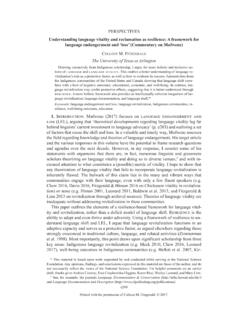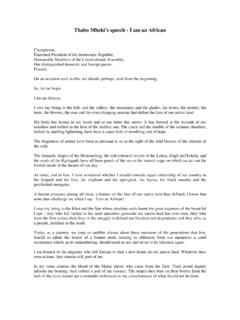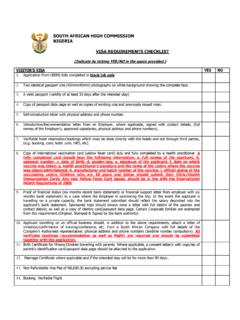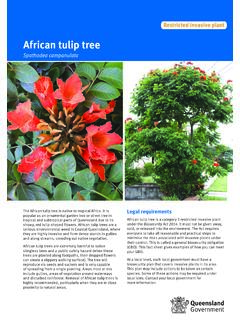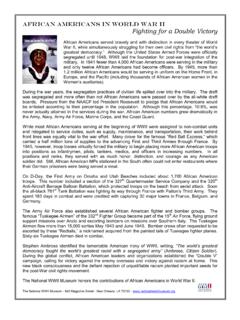Transcription of What is Ebonics? - Linguistic Society of America
1 The Linguistic Society of Americawas founded in1924 for the advancement of the scientific study of lan-guage. The Society serves its nearly 7,000 personaland institutional members through scholarly meetings,publications, and special activities designed toadvance the Society holds its Annual Meeting in early Januaryeach year and publishes a quarterly journal, LAN-GUAGE and the LSA Bulletin. Among its special educa-tion activities are the Linguistic Institutes held everyother summer in odd-numbered years and co-spon-sored by a host web site for the Society ( )includes a Directory of Programs in Linguistics in theUnited States and Canada, The Field of Linguistics(brief, nontechnical essays describing the disciplineand its subfields)
2 , and statements and resolutionsissued by the Society on matters such as languagerights, the English-only/English-plus debate, bilingualeducation, and 18th St, NW, Suite 211 Washington, DC 20036-6501(202) as neededLinguistic Society of AmericaOther linguists are drawn to the similaritiesbetween Ebonics and Caribbean Creole English varieties, for instance, the fact that both frequentlydrop isand are, and that both permit droppingword initial d, b, and gin tense-aspect markers(Caribbean examples include habitual/progressive(d)a, past tense (b)en, and future (g)on).
3 Thesetraits suggest that some varieties of AmericanEbonics might have undergone the kinds of simplifi-cation and mixture associated with Creole forma-tion in the Caribbean and elsewhere. They mightalso suggest that American Ebonics was shaped bythe high proportions of Creole-speaking slaves thatwere imported from the Caribbean in the earliestsettlement periods of the thirteen original colonies. Arguments about and evidence on the origins issuecontinue to be brought forth. A relatively new his-torical issue has emerged in recent years: IsEbonics converging with or diverging from othervernacular varieties of American English?
4 One thingis for sure: This dynamic, distinctive variety thor-oughly intertwined with african American historyand linked in many ways with african American literature, education, and social life is one of themost extensively studied and discussed varieties ofAmerican English, and it will probably continue tobe so for many years to come. Further readingBaugh, John. 2000. Beyond Ebonics: Linguistic prideand racial prejudice. Oxford: Oxford University , Lisa. 2002. african American English: A linguis-tic introduction. Cambridge: Cambridge University , William. 1973. Language in the inner city: Studiesin the Black English Vernacular.
5 Philadelphia: Universityof Pennsylvania , Shana, ed. 2000. The English history of AfricanAmerican English. Malden, MA, and Oxford, , John R. , and Russell J. Rickford. 2000. SpokenSoul: The story of Black English. New York: John , Geneva. 2000. Black talk: Words andphrases from the hood to the amen corner. New York:Houghton , Walt, and Erik R. Thomas. 2002. The develop-ment of african American English. Malden, MA, andOxford, UK: isEbonics?( african AmericanVernacularEnglish)Written by John R. Rickford,Stanford University Some deny its existence (like the black Chicagoanwhose words Ain t nobody here talkin no Ebonics belied his claim).
6 Others deprecate it (like MayaAngelou, who found the Oakland School Board s 1996 Ebonics resolutions very threatening although sheuses Ebonics herself in her poems, ThePusher ). It should be said, incidentally, that at least some ofthe overwhelmingly negative reaction to the Oaklandresolutions arose because the resolutions were misin-terpreted as proposals to teach Ebonics itself, or toteach in Ebonics, rather than as proposals to respectand take it into account while teaching standardEnglish. The method of studying language known as contrastive analysis involves drawing students attention to similarities and differences betweenEbonics and Standard English.
7 Since the 1960s, it hasbeen used successfully to boost Ebonics speakers reading and writing performance in Standard English,most recently in public schools in DeKalb County, GA,and in Los Angeles, CA (as part of the LA UnifiedSchool District s Academic English Mastery Program).Where did Ebonics come from? On this point, linguists are quite divided. Someemphasize its English origins, pointing to the fact thatmost of the vocabulary of Ebonics is from English andthat much of its pronunciation ( pronouncing finalthas f) and grammar ( double negatives, I don twant none ) could have come from the nonstandarddialects of English indentured servants and otherworkers with whom african slaves emphasize Ebonics african origins, noting thatWest african languages often lack thsounds and finalconsonant clusters ( past)
8 , and that replacing orsimplifying these occurs both in US Ebonics and inWest african English varieties spoken in Nigeria andGhana. Moreover, they argue that the distinctionmade between completed actions ( He done walked )and habitual actions ( We be walkin ) in the Ebonicstense-aspect system reflects their prevalence in WestAfrican language systems and that this applies toother aspects of Ebonics sentence structure. Ebonics pronunciation includes features like the omission of the final consonant in words like past (pas ) and hand (han ), the pronunciation of the thin bath as t(bat) or f(baf), and the pronunciation of thevowel in words like my and ride as a long ah(mah,rahd).
9 Some of these occur in vernacular whiteEnglish, too, especially in the South, but in generalthey occur more frequently in Ebonics. Some Ebonicspronunciations are more unique, for instance, drop-ping b, d, or gat the beginning of auxiliary verbs like don t and gonna , yielding Ah on knowfor I don tknow and ama do itfor I m going to do it. What does Ebonics look like?These distinctive Ebonics pronunciations are all sys-tematic, the result of regular rules and restrictions;they are not random errors and this is equally trueof Ebonics grammar. For instance, Ebonics speakersregularly produce sentences without present tense isand are, as in John trippin or They allright.
10 Butthey don t omit present tense am. Instead of theungrammatical * Ah walkin , Ebonics speakers wouldsay * Ahm walkin. Likewise, they do not omit isandareif they come at the end of a sentence That swhat he/they is ungrammatical. Many members ofthe public seem to have heard, too, that Ebonicsspeakers use an invariant bein their speech (as in They be goin to school every day ); however, this beis not simply equivalent to isor are. Invariant berefers to actions that occur regularly or habituallyrather than on just one occasion. What do people think of Ebonics? That depends on whom you ask.

